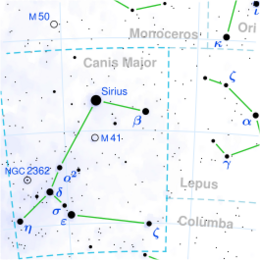Astronomy:FY Canis Majoris
| Observation data Equinox J2000.0]] (ICRS) | |
|---|---|
| Constellation | Canis Major |
| Right ascension | 07h 26m 59.48269s[1] |
| Declination | −23° 05′ 09.6897″[1] |
| Apparent magnitude (V) | 4.8 - 6.25[2] |
| Characteristics | |
| Spectral type | B0.5 IVe[3] |
| Variable type | γ Cas[2] |
| Astrometry | |
| Proper motion (μ) | RA: −6.692±0.038[1] mas/yr Dec.: +4.054±0.078[1] mas/yr |
| Parallax (π) | 1.7919 ± 0.0645[1] mas |
| Distance | 1,820 ± 70 ly (560 ± 20 pc) |
| Absolute magnitude (MV) | −2.23[4] |
| Orbit[5] | |
| Primary | Be star |
| Companion | hot subdwarf |
| Period (P) | 37.257±0.003 d |
| Inclination (i) | >66[6]° |
| Periastron epoch (T) | 2448529.64±0.15 |
| Semi-amplitude (K1) (primary) | 14.4±0.9 km/s |
| Semi-amplitude (K2) (secondary) | 128.2±2.2 km/s |
| Details | |
| Be star | |
| Mass | 10-13[6] M☉ |
| Radius | 6.8[6] R☉ |
| Luminosity | 26,915[6] L☉ |
| Temperature | 27,500±3,000[5] K |
| Rotational velocity (v sin i) | 340±40[5] km/s |
| hot subdwarf | |
| Mass | 1.1-1.5[6] M☉ |
| Radius | 0.81[6] R☉ |
| Luminosity | 2,399[6] L☉ |
| Temperature | 45,000±5,000[5] K |
| Rotational velocity (v sin i) | 41±5[5] km/s |
| Other designations | |
| Database references | |
| SIMBAD | data |
FY Canis Majoris (FY CMa), also known as HD 58978, is a star about 1,800 light years from the Earth, in the constellation Canis Major (very near the border of Puppis). It is usually a 5th magnitude star, so it will be visible to the naked eye of an observer far from city lights. It is a Gamma Cassiopeiae variable star, whose brightness varies from magnitude 4.8 to 6.25.

In 1967, Alejandro Feinstein detected low amplitude (0.14 magnitude) variability in HD 58978's brightness, from photoelectric observations at La Plata Observatory.[10] The star was given the variable star designation FY Canis Majoris in 1973.[11] During an outburst in 2009, the star brightened to magnitude 4.8, its historical peak brightness.[2] TESS data show that FY CMa pulsates at many different frequencies, with periods ranging from 1.07 hours to 5.8 days.[12]
In 1905, Edward King noted that FY CMa has a peculiar spectrum with an unusually bright Hβ (and other) emission lines.[13] Paul Merrill et al. listed it as a Be star in 1925.[14] Spectra taken by various observers over several decades of the 20th century showed that the strength and relative intensities of the star's emission line are variable,[3] and could change on a timescale of just a few days.[15]
In 2008, Geraldine Peters et al. obtained high resolution spectra from the IUE and found that the Be star has hot, far less massive subdwarf companion star, with which it forms a spectroscopic binary.[5]
Hui-Lau Cao calculated that FY CMa is losing mass at a rate of about 6 × 10−8 M☉/year via a stellar wind with a terminal velocity of about 750 km/sec.[16]
References
- ↑ 1.0 1.1 1.2 1.3 1.4 Vallenari, A. et al. (2022). "Gaia Data Release 3. Summary of the content and survey properties". Astronomy & Astrophysics. doi:10.1051/0004-6361/202243940 Gaia DR3 record for this source at VizieR.
- ↑ 2.0 2.1 2.2 "FY CMa". AAVSO. https://www.aavso.org/vsx/index.php?view=detail.top&oid=5341.
- ↑ 3.0 3.1 Slettebak, A. (September 1982). "Spectral types and rotational velocities of the brighter Be stars and A-F type shell stars". Astrophysical Journal Supplement Series 50: 55–83. doi:10.1086/190820. Bibcode: 1982ApJS...50...55S.
- ↑ Anderson, E.; Francis, Ch. (May 2012). "XHIP: An extended hipparcos compilation". Astronomy Letters 38 (5): 331–346. doi:10.1134/S1063773712050015. ISSN 1063-7737. Bibcode: 2012AstL...38..331A.
- ↑ 5.0 5.1 5.2 5.3 5.4 5.5 Peters, Geraldine J.; Gies, Douglas R.; Grundstrom, Erika D.; McSwain, M. Virginia (October 2008). "Detection of a Hot Subdwarf Companion to the Be Star FY Canis Majoris". Astrophysical Journal 686 (2): 1280–1291. doi:10.1086/591145. Bibcode: 2008ApJ...686.1280P.
- ↑ 6.0 6.1 6.2 6.3 6.4 6.5 6.6 Nazé, Yaël; Rauw, Gregor; Smith, Myron A.; Motch, Christian (2022). "The X-ray emission of Be+stripped star binaries★". Monthly Notices of the Royal Astronomical Society 516 (3): 3366. doi:10.1093/mnras/stac2245. Bibcode: 2022MNRAS.516.3366N.
- ↑ "HD 58978 -- Be Star". SIMBAD. Centre de données astronomiques de Strasbourg. http://simbad.u-strasbg.fr/simbad/sim-basic?Ident=HD+58978+--+Be+Star.
- ↑ "ASAS All Star Catalogue". The All Sky Automated Survey. http://www.astrouw.edu.pl/asas/?page=aasc.
- ↑ "MAST: Barbara A. Mikulski Archive for Space Telescopes". Space Telescope Science Institute. https://mast.stsci.edu/portal/Mashup/Clients/Mast/Portal.html.
- ↑ Feinstein, A. (1968). "A Survey of Southern Be Stars. II. Photometric data". Zeitschrift für Astrophysik 68: 29–47. Bibcode: 1968ZA.....68...29F.
- ↑ Kukarkin, B. V.; Kholopov, P. N.; Kukarkina, N. P.; Perova, N. B. (October 1973). "59th Name-List of Variable Stars". Information Bulletin on Variable Stars 834 (1): 1. Bibcode: 1973IBVS..834....1K. https://ibvs.konkoly.hu/pub/ibvs/0801/0834.pdf. Retrieved 2 February 2023.
- ↑ Balona, L. A.; Ozuyar, D. (April 2020). "TESS observations of Be stars: a new interpretation". Monthly Notices of the Royal Astronomical Society 493 (2): 2528–2544. doi:10.1093/mnras/staa389. Bibcode: 2020MNRAS.493.2528B.
- ↑ Pickering, Edward C.; Fleming, W. P. (July 1905). "Stars having peculiar spectra. Spectra of known variables". Astrophysical Journal 22: 87–90. doi:10.1086/141242. Bibcode: 1905ApJ....22...87P.
- ↑ Merrill, P. W.; Humason, M. L.; Burwell, C. G. (June 1925). "Discovery and Observations of Stars of Class Be". Astrophysical Journal 61: 389–417. doi:10.1086/142899. Bibcode: 1925ApJ....61..389M.
- ↑ Peters, G. J. (May 1987). "FY Canis Majoris". IAU Circ. 4391: 2. Bibcode: 1987IAUC.4391....2P. http://www.cbat.eps.harvard.edu/iauc/04300/04391.html#Item0. Retrieved 1 February 2023.
- ↑ Cao, Hui-Lai (December 2001). "Infall and Outflow Activities in the Be star FY CMa". Chinese Journal of Astronomy & Astrophysics 1 (6): 514–524. doi:10.1088/1009-9271/1/6/514. Bibcode: 2001ChJAA...1..514C.
 |


